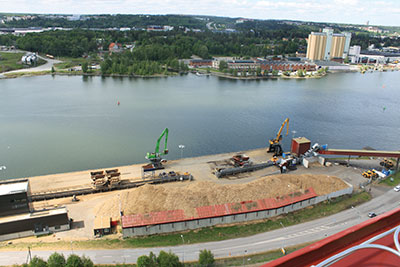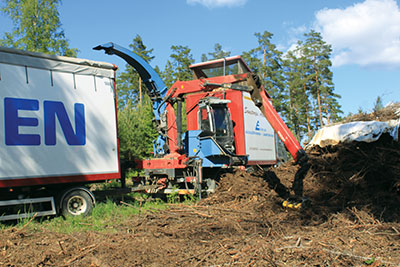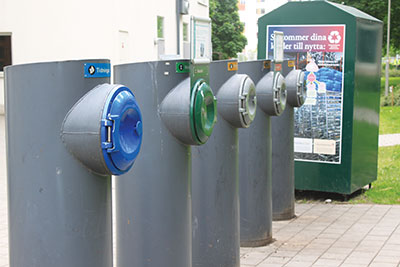
Bioenergy in use
August 5, 2014
By
Amie Silverwood
Bioenergy has the reputation for being expensive and risky, but on a recent trip to Sweden, Canadian Biomass was given the opportunity to see how technology that has been in use for decades in Sweden has brought wealth, new jobs and reduced the country’s reliance on imported fossil fuels.
Bioenergy has the reputation for being expensive and risky, but on a recent trip to Sweden, Canadian Biomass was given the opportunity to see how technology that has been in use for decades in Sweden has brought wealth, new jobs and reduced the country’s reliance on imported fossil fuels.
 |
|
| Igelsta CHP plant mainly uses wood chips for district heat and power production. It also uses sorted paper, plastic and wood waste from industry and offices, which cannot be recycled.
|
Sweden, like Canada, is a sparsely populated, northern country with long, cold and dark winters. It has a landscape that resembles Ontario with a largely urban population, as 85 per cent of the 9.7 million people who populate the country live in cities. It also has a long coastline and forest covering 53 per cent of the land.
There are some 300,000 forest owners in Sweden, creating a management mosaic that is restricted by legislation and, for owners who choose to comply, by certification standards. Large areas of the forest have been set aside for conservation (5.5 million hectares), while 21.2 million hectares of productive forestland is under active management. Like Canada, forest products are one of the country’s traditional exports.
Igelsta CHP plant
Because forestry is one of the country’s major industries, it supplies a great deal of the country’s biomass for energy and heat production. Canadian Biomass had the opportunity to tour a combined heat and power plant (CHP) run by Söderenergi, one of the largest district heat producers in Sweden. In the company’s five plants, the majority of its fuel comes from forestry by-products (forest clippings, recovered wood waste) and industrial waste.
 |
|
| Most of the fuel arrives at the Igelsta CHP plant by boat at the Igelsta port (500,000 tonnes). About 200,000 tonnes of wood chips are transported by rail and about 300,000 tonnes are trucked in.
|
The industrial waste consists of paper, cardboard, plastic and wood that has been crushed, sieved, and cleaned of metals, sand and other contaminants, and cannot be used in any other way. The company aims to use renewable fuels whenever possible and is slowly increasing the amount of industrial waste that it burns, which includes demolition waste. Wood recovered from demolitions contain chemicals from paints and other contaminants that can damage the burners so the staff is monitoring the boilers closely and increasing this kind of fuel gradually. At the time of the visit, 45 per cent of the fuel used was recovered wood.
Igelsta is Sweden’s largest bio-fuelled CHP plant and is located in Södertälje, about 30 kilometres from Stockholm. Fired up in 2010, it produces 200MW of heat and 85 MW of electricity.
The majority of the fuel burned at Iglesta is shipped to the plant by boat (about 500,000 tonnes) and arrives at the small port onsite. The port handles around 200 ships a year from Sweden and other parts of Europe. Fuel from nearby forest operations arrives by rail and is then trucked the short distance (15 kilometres) to the CHP plant.
The company has placed strict requirements on its fuel suppliers, taking samples from every load delivered. Quality checks are based on a fuel specification, which has been agreed upon by Söderenergi and the supplier. Random samples are taken mechanically from various places in the load in order to obtain a representative result. Monthly samples are collected for each supplier and sent for analysis to an accredited laboratory. The company uses a data system, Safirs, to monitor the fuel quality and economy. It provides information on the fuel flow from supplier to combustion with data on fuel consumption and analysis results through a weighing system.
Once on site, the fuel is stored in large silos at the back of the property. The wood chips or industrial waste pellets travel from the silos to the boiler on a system of conveyor belts that feed the boiler. The boiler heats water to produce steam, which turns a turbine to power a generator that produces electricity. This electricity is fed into the power grid, while the surplus heat from the process is used in the district heating network for homes and industries (about 70 per cent). Heat, in the form of hot water at around 120 degrees Celsius, is pumped through underground pipes to a network of buildings where it supplies heat and hot water. Once these homes have been heated, the water is returned to the source where it is reheated to begin the process anew. The district heating network Igelsta supplies is 450 kilometres long.
Sustainable future in sight
District heating and co-generation facilities like the Igelsta CHP plant are part of the Swedish shift to a more sustainable and cleaner future. The shift began in the 1970s when residents became concerned with the levels of smog and acidification of the country’s lakes and forests. District heating meant a shift from inefficient stoves in every home to a shared heat source run by professionals that would include sophisticated cleaning equipment to ensure the chimney plumes release steam rather than dirty smoke.
The chimneys in both the Igelsta DH plant and the CHP plant contain fully equipped laboratories. Though the smoke may look hazardous as it flows from the chimneys, the exhaust is constantly monitored to ensure it is clean air and steam. The white smoke is the hot water in the flue gas, which forms droplets in the air. No matter which fuel is used to power the turbines, the proportion of contaminants in the steam is very small.
There are many district heating grids throughout the country that use whatever fuel is regionally available. In forested areas, forestry by-products are the obvious choice, and in the city of Stockholm, household waste is the fuel of choice. Organic waste is collected to produce the biogas used to power the city buses. Whatever the feedstock, chimney exhaust is monitored so that the air is kept free of contaminants.
Stability and long-term general steering
Johan Thorsell is the business support manager for Växjö, the “Greenest City in Europe.” He credits brave politicians for creating a carbon tax that required the “bad guys pay the good guys.” Priority was given to increasing the cost of all fossil fuel-based energy rather than giving subsidies to renewable energy. All renewable energy competed on equal terms, thus developing the whole industry rather than the political favourites.
 |
|
| Wood waste from local forestry operations is a major feedstock for district heat and power production. This truck has a loader and grinder that chips the wood directly into the back of the truck and is owned and operated by one contractor.
|
“The road map must be simple and easy to understand,” said Thorsell who championed a simple pyramid to illustrate his key principles. Avoid energy needs (at the bottom level of the pyramid), streamline and reduce energy demand (mid layer) and use renewables (on the top).
His city plans to be fossil fuel free by 2030. One of the main components in this plan is to encourage the use of wood as a building material in order to provide additional wood waste for biofuel. Twenty-five per cent of each tree is used for biofuel in Sweden. Ten thousand square metres of a forest harvest makes 15m3 of oil and 1,000 kg of oil provides 11MWh of energy. The city is currently building its third-generation power plant that will cover 50 per cent of local demand for electricity from wood waste (tops, roots and bark). It will provide 39 MW of electricity and 64 MW of heat and consume at top load 140 m3/h reducing the city’s CO2 production by between 10,000 to 20,000 tonnes a year. The estimated cost is 1.2 billion SEK.
The city of Växjö is an interesting example of a green city because of the benefits it has reaped from its efforts. As the city has invested in technologies and programs to reduce CO2 emissions, there has been a notable economic growth at the same time. Bengt-Erik Löfgren, CEO of ÄFAB (a bioenergy consultancy), explained that green cities attract businesses that want to be associated with a sustainable vision.
“The use of locally produced biomass has reduced the dependence on fossil fuels and has raised the GDP by 43 per cent,” said Löfgren. He pointed out some impressive gains experienced in his town. Replacing fossil fuel-derived energy with locally sourced renewables added 23,650 jobs. Curbing energy use has added 13,000 jobs and recycling has added 18,600 jobs.
Hammarby Sjöstad and Stockholm Royal Seaport
A Swedish construction firm recently conducted a survey that found seven out of 10 Swedes want to live in a building with an eco label and would pay more for it. There are a number of choices of new construction built to high eco standards to use less energy or passive houses that are heated primarily with the heat generated by the electrical appliances, lighting, sunlight and through the warmth of the people in the buildings themselves.
Canadian Biomass visited Hammarby Sjöstad, Stockholm’s largest urban construction project, which is on a former brownfield between the inner city and suburbs; it was transformed to house 26,000 people by 2017. Designed to be a model of sustainable housing, it has been a popular destination for city planners and politicians worldwide.
 |
|
| Waste is transported underground through a waste vacuum system and processed at a nearby facility.
|
From the moment of the author’s arrival in the neighbourhood, it was evident that Hammarby Sjöstad is more vibrant than most urban densification projects. The population on the street in early June was primarily young parents and their children who were enjoying the green public spaces between residences (children aged 0-5 make up 13 per cent of the area’s population). This generation of parents makes an obvious fit for a neighbourhood designed to preserve the natural resources for the next generation, but diapers and picky eaters generate a great deal of waste regardless of a parent’s good intentions.
The waste generated in Hammarby Sjöstad is not wasted, however, it is the fuel that powers the neighbourhood. Waste is separated into organic, combustible and newspaper and transported underground through a waste vacuum system to a nearby handling facility. Other waste is collected onsite and recycled so that there is no waste bound for landfills. Combustible waste that has no other use is burned and the heat and electricity is fed back into the district’s grid.
Following the success and lessons learned from the construction of Hammarby Sjöstad, the Stockholm Royal Seaport has been designed with similar values in mind to produce 10,000 homes and 30,000 offices, to be built by 2025. City planners have gained enough experience and confidence to aim to build this new development into a fossil fuel-free zone in 2030 and to reduce the CO2 emissions produced to less than 1.5 tonnes per person by 2025.
Some areas of focus for the development team include: wave power, pyrolysis oil, advancing the rapid adoption of electric vehicles, district heating, nuclear CHP, and the NURES liquid treatment system for radioactive liquids. There will be methods for individuals to monitor their uses of heating, waste and electricity and benchmarks they’re expected to meet.
This neighbourhood is being built to support innovation with extra space allotted to educating visitors on the sustainable technology being developed, schools, daycares and a former gas container reconstructed for an opera house.
As cities around the world look for best practices for remediation of brownfields and industrial lands and as we look for places for our cities to grow without diminishing our parks and nature preserves, Stockholm has taken up the gauntlet to lead the way. Sweden has proven that a fossil-free future is not only within reach, it is within our means.
Print this page